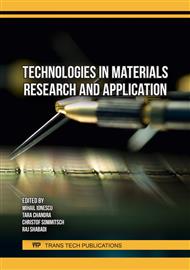[1]
J. Lee, H.-A. Kao, S. Yang, Service innovation and smart analytics for industry 4.0 and big data environment, Procedia Cirp. 16 (2014), 3–8.
DOI: 10.1016/j.procir.2014.02.001
Google Scholar
[2]
A.K. Vasudevan, R.D. Doherty, Aluminum Alloys-Contemporary Research and Applications: Contemporary Research and Applications, Elsevier (2012).
Google Scholar
[3]
B. Prillhofer, H. Antrekowitsch, H. Bottcher, P. En-Right., Nonmetallic inclusions in the secondary aluminium industry for the production of aerospace alloys. In LIGHT METALS-WARRENDALE-PROCEEDINGS, TMS (2008), 603.
Google Scholar
[4]
M.R. Berthold, C. Borgelt, F. Höppner, F. Klawonn, Guide to Intelligent Data Analysis: How to Intelligently Make Sense of Real Data, Springer London (2010)
DOI: 10.1007/978-3-030-45574-3
Google Scholar
[5]
Information on https://rstudio-pubs-static.s3.amazonaws.com/223423_ 8ca6fccca1e44939be 3f85ecbfa9598f.html
Google Scholar
[6]
D.P. Kroese, T. Brereton, T. Taimre, Z.I. Botev, Why the Monte Carlo method is so important today, WIREs Comput Stat. (2014), 386–392.
DOI: 10.1002/wics.1314
Google Scholar
[7]
R Core Team, R: A Language and Environment for Statistical Computing, R Foundation for Statistical Computing, Vienna, Austria (2022).
Google Scholar
[8]
G. Walz, Lexikon der Mathematik, first ed., Spektrum Akademischer Verlag, Mannheim/ Heidelberg, 2000.
Google Scholar
[9]
Information on https://www.spektrum.de/lexikon/physik/diskretisierung/3173.
Google Scholar
[10]
T. Hastie, R. Tibshirani, J. Friedman, The Elements of Statistical Learning, Springer (2001)
Google Scholar
[11]
M. Wand, KernSmooth: Functions for Kernel Smoothing Supporting Wand & Jones (1995), (2021) on https://CRAN.R-project.org/package=KernSmooth
Google Scholar
[12]
M. p. Wand, M. C. Jones:,Kernel Smoothing, Chapman and Hall, London (1995)
Google Scholar
[13]
W.W. Burchett, A.R. Ellis, S.W. Harrar, A. C. Bathke, Nonparametric Inference for Multivariate Data: The R Package npmv, Journal of Statistical Software (2017), 1-18
DOI: 10.18637/jss.v076.i04
Google Scholar
[14]
L. Sachs, J. Hedderich, Angewandte Statistik: Methodensammlung mit R, 8 ed., Springer Spektrum, Berlin/ Heidelberg (2018)
Google Scholar
[15]
H. Wickham, Elegant Graphics for Data Analysis, Springer-Verlag New York (2016) on https://ggplot2.tidyverse.org
Google Scholar



